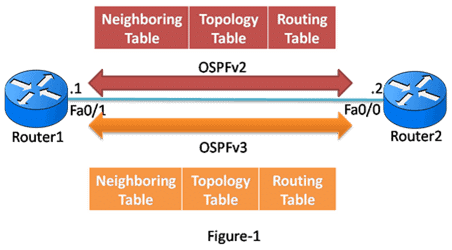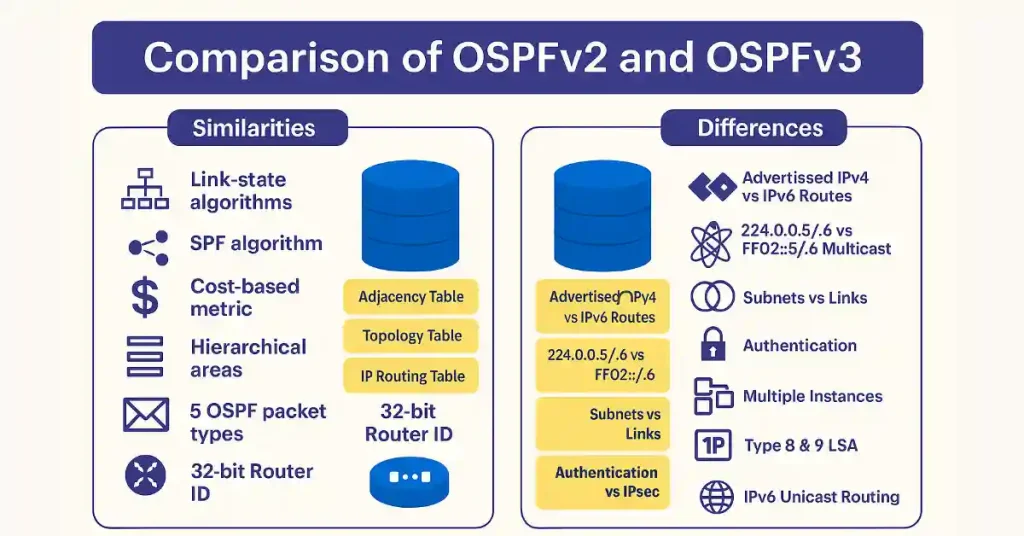OSPFv3 is a routing protocol for IPv6, just as OSPFv2 is for IPv4. While both share core principles, there are vital differences in their operation. OSPFv3 serves as the IPv6 equivalent to OSPFv2 for exchanging prefixes, making it essential for modern networks handling dual-stack environments.
In IPv6, the network address is referred to as the prefix, and the subnet mask is called the prefix length. Similar to IPv4, OSPFv3 exchanges routing information to populate the IPv6 routing table with remote prefixes. The OSPFv3 Address Families (AF) feature supports both IPv4 and IPv6 within a single OSPF process, allowing efficient dual-stack routing. (CCNP Note: This enables multi-AF configurations, reducing overhead in mixed environments.)
OSPFv2 operates over the IPv4 network layer, communicating with other OSPFv2 peers and advertising only IPv4 routes. OSPFv3 provides similar functionality but uses IPv6 as the network layer transport, communicating with OSPFv3 peers and advertising IPv6 routes. Unlike OSPFv2, it is designed to be network protocol independent, supporting extensions beyond IPv6.
OSPFv3 also uses the Shortest Path First (SPF) algorithm as the computation engine to determine the best paths throughout the routing domain.

Along with all IPv6 routing protocols, version 3 has separate processes from its IPv4 equivalent. The processes and operations are the same as in the IPv4 routing protocol but run separately. Both have separate adjacency tables, OSPF topology tables, and IP routing tables, as shown in the figure. The configuration and verification commands are similar for both protocols.
The figure above illustrates the operational differences between OSPFv2 and OSPFv3, showing how each handles routing in their respective IP versions.
Like other IPv6 routing protocols, OSPFv3 runs separate processes from its IPv4 counterpart (OSPFv2). The processes and operations are similar but execute independently. Both maintain separate adjacency tables, OSPF topology tables, and IP routing tables.
| Component | OSPFv2 | OSPFv3 |
|---|---|---|
| Adjacency Table | IPv4-based | IPv6-based (link-local) |
| Topology Table | LSDB for IPv4 | LSDB for IPv6 |
| Routing Table | IPv4 routes | IPv6 routes |
Configuration and verification commands are similar, e.g., show ip ospf vs show ipv6 ospf.
Similarities Between Both Versions
- Link-State Routing: Both use link-state algorithms and are classless.
- Routing Algorithm: Both employ the SPF algorithm for routing decisions.
- Metric: Both use cost based on interface bandwidth, modifiable with auto-cost reference-bandwidth ref-bw.
- Areas: Both support hierarchical areas for scalability.
- OSPF Packet Types: Same five packets: Hello, DBD, LSR, LSU, LSAck.
- Neighbor Discovery: Similar state machine; no subnet matching required in OSPFv3 (uses link-local).
- DR/BDR Election: Identical process.
- Router ID: 32-bit, prefers configured ID or highest loopback IPv4 address.
Differences Between Both Versions
| Feature | OSPFv2 | OSPFv3 |
|---|---|---|
| Advertised Routes | IPv4 routes | IPv6 routes |
| Source Address | IPv4 exit interface | Link-local IPv6 address |
| Multicast Addresses | 224.0.0.5 (AllSPFRouters), 224.0.0.6 (AllDRouters) | FF02::5 (AllSPFRouters), FF02::6 (AllDRouters) |
| Network Advertisement | Uses network command | Uses ipv6 ospf process-id area area-id on interfaces |
| Unicast Routing | IPv4 enabled by default | Requires ipv6 unicast-routing |
| Authentication | Plaintext or MD5 | IPsec (AH/ESP) |
| Multiple Instances | Limited support | Supports multiple instances per interface (CCNP advanced) |
| LSA Types | Standard LSA types (1–7) | Introduces Type 8 (Link LSA), Type 9 (Intra-Area Prefix LSA); runs on links, not subnets |
| Flooding Scope | Area and AS scope | Adds link-local scope |
FAQs
What are the key similarities between both?
Both are link-state, classless protocols using the SPF algorithm for routing decisions. They share metrics based on interface cost, support hierarchical areas, use the same five OSPF packet types (Hello, DBD, LSR, LSU, LSAck), have identical DR/BDR election processes, and employ a 32-bit router ID. Neighbor discovery follows a similar state machine.
How do OSPFv2 and v3 differ in authentication and multicast addresses?
OSPFv2 uses plaintext or MD5 authentication and multicast addresses 224.0.0.5/6. OSPFv3 leverages IPsec (AH/ESP) for security and uses FF02::5/6. These changes enhance IPv6 support, with OSPFv3 also introducing link-local scoping for flooding and multiple instances per interface for advanced CCNP scenarios.
What commands are used to configure OSPFv3 versus OSPFv2?
For OSPFv2, use router mode commands like ‘router ospf 1’, ‘router-id 1.1.1.1’, and ‘network 192.168.1.0 0.0.0.255 area 0’. OSPFv3 requires ‘ipv6 unicast-routing’ globally, then interface mode ‘ipv6 ospf 1 area 0’. This per-interface approach in OSPFv3 simplifies IPv6 prefix advertisement without subnet requirements.
Why does OSPFv3 introduce new LSA types like Type 8 and 9?
It operates on links rather than subnets, so Type 8 (Link LSA) handles link-local information and IPv6 prefixes on a link, while Type 9 (Intra-Area Prefix LSA) advertises prefixes within an area. This separates topology from addressing, enabling better IPv6 support compared to OSPFv2’s integrated approach.
How can I verify and troubleshoot OSPFv3 configurations?
Use ‘show ipv6 ospf neighbor’ for adjacencies, similar to ‘show ip ospf neighbor’ in OSPFv2. Check router ID conflicts, authentication mismatches, and ensure ‘ipv6 unicast-routing’ is enabled. For multi-area, verify separate processes and databases to maintain dual-stack stability in mixed IPv4/IPv6 environments.





